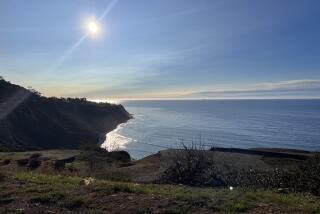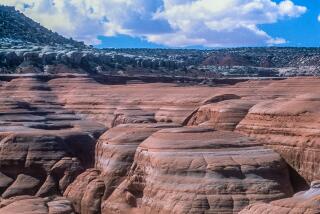Crash Likely to Spark New Debate Over Park Flights
The crash of a Grand Canyon tour plane Wednesday is likely to spark new debate over whether more restrictions should be imposed on aircraft flying over national parks.
A deadly collision over the canyon in 1986 was responsible for the passage of a law the following year prohibiting aircraft from flying below the canyon rim and restricting planes to certain routes and altitudes.
But environmental groups have pressed for a complete flight ban over the canyon to preserve its quiet and tranquility, and the National Park Service is studying the possibility of putting more of the Grand Canyon and other national parks off limits to aircraft.
Although Wednesday’s crash, which killed 10 passengers, occurred at an airport about seven miles from the park, it “once again raises questions of just how safe this whole operation is,” National Park Service spokesman Duncan Moore said.
“If flights are going to be tightly controlled over the canyon, it may require the investment of a major traffic control system at Grand Canyon Airport,” he said. “This crash will raise again the question of just how reliable the air traffic control system is.”
For years, the Park Service has wanted the Federal Aviation Administration to build a radar system at the Grand Canyon Airport to regulate flights within the park. Even though the absence of radar was not blamed for Wednesday’s accident, the crash gives opponents of the flights more ammunition.
“If I were a tourist, I would be asking some questions,” said Maggie Fox, southwest regional director of the Sierra Club, which favors a more tightly “orchestrated” air traffic control system. “You have to find out why this plane crashed, but I also would be asking what are the parameters of controls over these flights. There is an unfortunate history here.”
The FAA has rejected Park Service requests for radar.
“The traffic doesn’t meet radar requirements,” George Sullivan, an FAA manager responsible for Grand Canyon air traffic, said Wednesday. “There just isn’t enough (traffic), and radar is very expensive. Now if Congress comes back and says they want us to do that (install radar), we’ll do it.”
Sullivan refused to speculate on whether radar will be necessary if new regulations are adopted to further restrict aircraft over the canyon. Those put into effect after the 1986 crash have already squeezed more aircraft into a smaller air space.
“We do compress them,” Sullivan said. “There’s no doubt about it.”
The new rules have also made canyon flights safer, he added. Even though pilots continue to operate under visual flight rules, which means “see and be seen,” planes flying in different directions now must fly at different altitudes.
The Sierra Club wants aircraft banned from the canyon altogether and at a minimum, supports more restrictions.
“If you determine you don’t have any flights below the rim, and certain areas are off limits, and you have a whole lot of tour operators that want to fly over it, you are going to have to orchestrate exactly who takes off when and exactly what patterns they take once they take off,” the Sierra Club’s Fox said.
More to Read
Sign up for Essential California
The most important California stories and recommendations in your inbox every morning.
You may occasionally receive promotional content from the Los Angeles Times.











